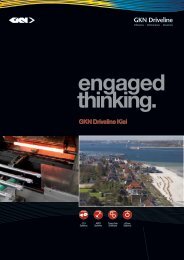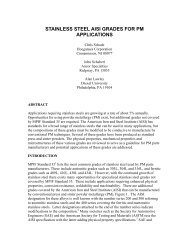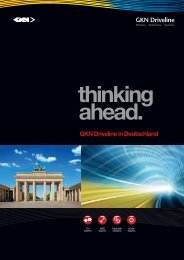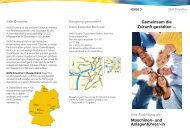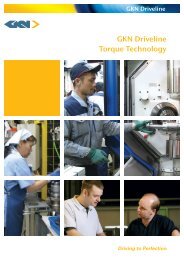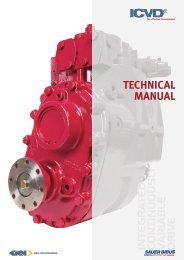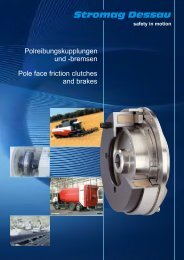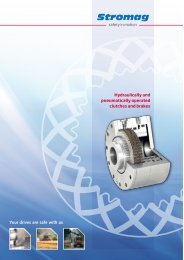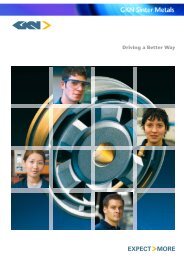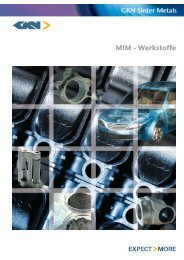Ancorsteel® Phosphorus Alloys - GKN
Ancorsteel® Phosphorus Alloys - GKN
Ancorsteel® Phosphorus Alloys - GKN
You also want an ePaper? Increase the reach of your titles
YUMPU automatically turns print PDFs into web optimized ePapers that Google loves.
0810-ASPA-D-2<br />
Ancorsteel phosphorus alloys are ferrous base<br />
powders for P/M parts requiring superior<br />
electromagnetic performance. Compared with<br />
parts made from pure, high compressibility iron<br />
powders, those made from the phosphorus alloys<br />
have higher resistivity, permeability and<br />
induction, and reduced coercive force. The<br />
presence of phosphorus also decreases the<br />
susceptibility of a P/M component to nitrogen<br />
aging. Ancorsteel phosphorus alloys are produced<br />
by making ferrophosphorus additions to the highly<br />
compressible iron powders Ancorsteel 1000B or<br />
Ancorsteel 1000C.<br />
Induction (Gauss)<br />
Hysteresis Loop with Initial (B-H) Curve<br />
Residual Induction<br />
Coercive Force-Hc<br />
Drive Field (Oe)<br />
NORTH AMERICA (Headquarters) Cinnaminson, NJ: +1-856-829-2220, tim.hale@hoeganaes.com<br />
EUROPE Meerbusch, Germany: +49-2132-6598-20, klaus.vossen@hoeganaes.com<br />
Pg 1 of 3<br />
Ancorsteel ®<br />
<strong>Phosphorus</strong> <strong>Alloys</strong><br />
Components made from the phosphorus alloys<br />
exhibit a good combination of tensile strength,<br />
ductility, and impact absorption energy. The<br />
particle size of the added ferrophosphorus is<br />
important as it has a significant effect on these<br />
properties. The ferrophosphorus powder should<br />
be finer than 20 micrometers and preferably<br />
should have a median particle size close to<br />
10 micrometers.<br />
The Hoeganaes Corporation products<br />
Ancorsteel 45P and Ancorsteel 80P contain<br />
0.45 and 0.80 weight % (w/o) phosphorus<br />
respectively.<br />
Typical applications for parts made from<br />
Ancorsteel phosphorus alloys include speed<br />
sensors, magnetic solenoids and plungers.<br />
Maximum<br />
Flux Density<br />
Slope = [Relative]<br />
Max. Permeability<br />
ASIA Kyeonggi-Do, Korea: +82-31-782-5952, helen.cho@hoeganaes.com<br />
Shanghai, China: +86-21-513-48999, william.wang@hoeganaes.com<br />
Tokyo, Japan: +81-3-5476-6165, tony.nishida@hoeganaes.com
0810-ASPA-D-2<br />
Data Sheet<br />
Ancorsteel ®<br />
<strong>Phosphorus</strong> <strong>Alloys</strong><br />
Typical Magnetic Properties<br />
Pg 2 3 of 34<br />
Grade Ancorsteel 1000B<br />
Compaction pressure, MPa (tsi) 415 (30) 550 (40) 690 (50)<br />
Sintering temperature, ˚C (˚F) 1120 (2050) 1260 (2300) 1120 (2050) 1260 (2300) 1120 (2050) 1260 (2300)<br />
Sintered density, g/cm 3 6.79 6.80 7.09 7.12 7.26 7.28<br />
[Relative] maximum<br />
permeability, G/Oe<br />
2100 2300 2600 2800 3000 3200<br />
Maximum flux density, [T] 1.03 1.07 1.12 1.20 1.26 1.30<br />
Maximum flux density, G 10300 10700 11200 12000 12600 13000<br />
Residual induction, [T] 0.90 0.95 1.10 1.12 1.14 1.18<br />
Residual induction, G 9000 9500 11000 11200 11400 11800<br />
Coercive force, [A/m] 170 160 170 150 160 150<br />
Coercive force, Oe 2.10 1.95 2.10 1.85 2.05 1.90<br />
Grade Ancorsteel 45P<br />
Compaction pressure, MPa (tsi) 415 (30) 550 (40) 690 (50)<br />
Sintering temperature, ˚C (˚F) 1120 (2050) 1260 (2300) 1120 (2050) 1260 (2300) 1120 (2050) 1260 (2300)<br />
Sintered density, g/cm 3 6.84 7.15 7.12 7.35 7.27 7.45<br />
[Relative] maximum<br />
permeability, G/Oe<br />
2800 4200 2900 4000 3600 4500<br />
Maximum flux density, [T] 1.10 1.30 1.25 1.32 1.30 1.39<br />
Maximum flux density, G 11000 13000 12500 13200 13000 13900<br />
Residual induction, [T] 0.95 1.10 1.07 1.05 1.14 1.19<br />
Residual induction, G 9500 11000 10700 10500 11400 11900<br />
Coercive force, [A/m] 140 110 140 110 140 100<br />
Coercive force, Oe 1.80 1.40 1.80 1.35 1.75 1.30<br />
Grade Ancorsteel 80P<br />
Compaction pressure, MPa (tsi) 415 (30) 550 (40) 690 (50)<br />
Sintering temperature, ˚C (˚F) 1120 (2050) 1260 (2300) 1120 (2050) 1260 (2300) 1120 (2050) 1260 (2300)<br />
Sintered density, g/cm 3 6.86 7.15 7.16 7.30 7.34 7.41<br />
[Relative] maximum<br />
permeability, G/Oe<br />
3800 4800 4500 5700 4500 6000<br />
Maximum flux density, [T] 1.20 1.38 1.32 1.38 1.30 1.40<br />
Maximum flux density, G 12000 13800 13200 13800 13000 14000<br />
Residual induction, [T] 1.05 1.10 1.12 1.18 1.15 1.25<br />
Residual induction, G 10500 11000 11200 11800 11500 12500<br />
Coercive force, [A/m] 120 110 120 100 110 100<br />
Coercive force, Oe 1.50 1.35 1.45 1.30 1.40 1.30<br />
Sintering was done in a synthetic dissociated ammonia atmosphere for 30 minutes at temperature.<br />
Typical magnetic properties were tested at a peak drive field of 1200 A/m (15 oersteds).<br />
NORTH AMERICA (Headquarters) Cinnaminson, NJ: +1-856-829-2220, tim.hale@hoeganaes.com<br />
EUROPE Meerbusch, Germany: +49-2132-6598-20, klaus.vossen@hoeganaes.com<br />
ASIA Kyeonggi-Do, Korea: +82-31-782-5952, helen.cho@hoeganaes.com<br />
Shanghai, China: +86-21-513-48999, william.wang@hoeganaes.com<br />
Tokyo, Japan: +81-3-5476-6165, tony.nishida@hoeganaes.com
0810-ASPA-D-2<br />
Tensile Strength (MPa)<br />
Transverse Rupture Strength (MPa)<br />
Apparent Hardness (HRB)<br />
Data Sheet<br />
Ancorsteel ®<br />
Sintering Temperature (˚F)<br />
<strong>Phosphorus</strong> <strong>Alloys</strong><br />
550<br />
500<br />
450<br />
2100 2200 2300 2400<br />
400<br />
350<br />
60<br />
300<br />
250<br />
200<br />
40<br />
150<br />
100<br />
50<br />
20<br />
0<br />
1100 1150 1200 1250 1300<br />
0<br />
1350<br />
Sintering Temperature (˚C)<br />
1100<br />
1000<br />
900<br />
800<br />
700<br />
1100 1150 1200 1250 1300 1350<br />
Sintering Temperature (˚C)<br />
80<br />
70<br />
60<br />
50<br />
UTS<br />
Yield (0.2% offset)<br />
Sintering Temperature (˚F)<br />
2100 2200 2300 2400<br />
Sintering Temperature (˚F)<br />
2100 2200 2300 2400<br />
40<br />
1100 1150 1200 1250 1300 1350<br />
Sintering Temperature (˚C)<br />
Mechanical Properties - Ancorsteel 45P<br />
140<br />
120<br />
Tensile Strength (10 3 psi)<br />
Transverse Rupture Strength (10 3 psi)<br />
Dimensional Change (% from die size)<br />
Elongation [% in 25.4 mm (1 incn)]<br />
Impact Energy (Joules)<br />
20<br />
15<br />
10<br />
5<br />
0.25<br />
Sintering Temperature (˚F)<br />
2100 2200 2300 2400<br />
Pg 4 3 of 43<br />
0<br />
1100 1150 1200 1250 1300 1350<br />
Sintering Temperature (˚C)<br />
0<br />
-0.25<br />
-0.5<br />
-0.75<br />
-1<br />
Sintering Temperature (˚F)<br />
2100 2200 2300 2400<br />
-1.25<br />
1100 1150 1200 1250 1300 1350<br />
Sintering Temperature (˚C)<br />
160<br />
140<br />
120<br />
100<br />
80<br />
60<br />
40<br />
20<br />
Sintering Temperature (˚F)<br />
0<br />
0<br />
1100 1150 1200 1250 1300 1350<br />
Sintering Temperature (˚C)<br />
Samples compacted at 550 MPa (40 tsi) and sintered in a synthetic dissociated ammonia atmosphere<br />
for 45 minutes at temperature.<br />
2100 2200 2300 2400<br />
IMPORTANT NOTICE: The data shown are based on laboratory processing standard test specimens. Results may vary from those obtained in production processing.<br />
NORTH AMERICA (Headquarters) Cinnaminson, NJ: +1-856-829-2220, tim.hale@hoeganaes.com<br />
EUROPE Meerbusch, Germany: +49-2132-6598-20, klaus.vossen@hoeganaes.com<br />
100<br />
80<br />
60<br />
40<br />
20<br />
Impact Energy (ft. lbf)<br />
ASIA Kyeonggi-Do, Korea: +82-31-782-5952, helen.cho@hoeganaes.com<br />
Shanghai, China: +86-21-513-48999, william.wang@hoeganaes.com<br />
Tokyo, Japan: +81-3-5476-6165, tony.nishida@hoeganaes.com



